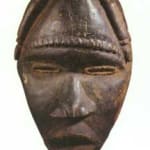Dan Wooden Tankangle Mask, 20th Century CE
Wood
11.625 x 20
PF.3948
In Carnival and Mardi Gras masks have multiple functions- as objects of beauty, to hide the identity of the wearer and to frighten others. In African societies, however, the use...
In Carnival and Mardi Gras masks have multiple functions- as objects of beauty, to hide the identity of the wearer and to frighten others. In African societies, however, the use of the mask not only includes these attributes, but goes far beyond them in making the mask a crucial part of village life. For instance, within the secret society of the go or leopard, the members worship and make offerings to a very powerful, pacifying spirit who is represented by a mask, the gogle. When worn in ceremonies the mask becomes an actual bush spirit, and consequently it is a great honor and responsibility for the person wearing it.
During ritual ceremonies men appeared in the form of spirits, dancing and singing, wearing masks such as this handsome example. It would have had an immediate and powerful impact on the audience, who instantly understood it's significance. Some were intended to be amusing, joking and playing with the people; others had a more serious role as escorts of warriors. This mask is beautifully crafted; its oval face gracefully curves around into full cheeks, then quickly comes together in a sharply pointed chin. The full lips fill the entire space of the chin, which balances the wide brow. The dual bands of hair nicely compliment the beaded band across the forehead. He is commanding and strong, yet his eyes reveal a gentler, almost impish glint, as they scan the scene before them. In the controlled frenzy of ritual dances, supernatural spirits came alive, briefly, to participate in village life through the medium of ceremony. To hold this powerful mask, to place it on the face, is to feel the exhilaration of a very old rite, as if we too are participating in a secret ritual of the go.
During ritual ceremonies men appeared in the form of spirits, dancing and singing, wearing masks such as this handsome example. It would have had an immediate and powerful impact on the audience, who instantly understood it's significance. Some were intended to be amusing, joking and playing with the people; others had a more serious role as escorts of warriors. This mask is beautifully crafted; its oval face gracefully curves around into full cheeks, then quickly comes together in a sharply pointed chin. The full lips fill the entire space of the chin, which balances the wide brow. The dual bands of hair nicely compliment the beaded band across the forehead. He is commanding and strong, yet his eyes reveal a gentler, almost impish glint, as they scan the scene before them. In the controlled frenzy of ritual dances, supernatural spirits came alive, briefly, to participate in village life through the medium of ceremony. To hold this powerful mask, to place it on the face, is to feel the exhilaration of a very old rite, as if we too are participating in a secret ritual of the go.
Literature
V19



